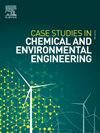CADMIUM(II) removal from aqueous solution by adsorption on water hyacinth (Eichhornia crassipes) hydrochar modified with citric acid
Q1 Environmental Science
Case Studies in Chemical and Environmental Engineering
Pub Date : 2025-07-28
DOI:10.1016/j.cscee.2025.101267
引用次数: 0
Abstract
This study is focused on synthesizing biosorbents from water hyacinth (Eichhornia crassipes), WH. Three biosorbents were obtained: WH modified with citric acid (WH-CA), hydrocarbonized WH (WHHC), and WHHC modified with CA (WHHC-CA). The capacity of these biosorbents to adsorb Cd(II) from water solutions was ascertained. WH and WHHC were modified hydrothermally using 2, 1 and 0.5 M CA solutions and were designated using CA concentration. All biosorbents were characterized using various techniques. At pH = 6 and 25 °C, WHHC-CA1 exhibited the highest capacity for adsorbing Cd(II) of 166.6 mg/g, so the optimal CA concentration is 1 M.

柠檬酸改性水葫芦(Eichhornia crassipes)氢炭吸附去除水中镉(II
研究了水葫芦(Eichhornia crassipes)的生物吸附剂的合成。得到了三种生物吸附剂:柠檬酸修饰WH-CA、碳化WH (WHHC)和CA修饰WHHC (WHHC-CA)。确定了这些生物吸附剂从水溶液中吸附Cd(II)的能力。分别使用2、1和0.5 M CA溶液对WH和WHHC进行水热改性,并使用CA浓度进行命名。使用各种技术对所有生物吸附剂进行了表征。在pH = 6和25℃条件下,WHHC-CA1对Cd(II)的吸附量最高,为166.6 mg/g,最佳CA浓度为1 M。
本文章由计算机程序翻译,如有差异,请以英文原文为准。
求助全文
约1分钟内获得全文
求助全文
来源期刊

Case Studies in Chemical and Environmental Engineering
Engineering-Engineering (miscellaneous)
CiteScore
9.20
自引率
0.00%
发文量
103
审稿时长
40 days
 求助内容:
求助内容: 应助结果提醒方式:
应助结果提醒方式:


